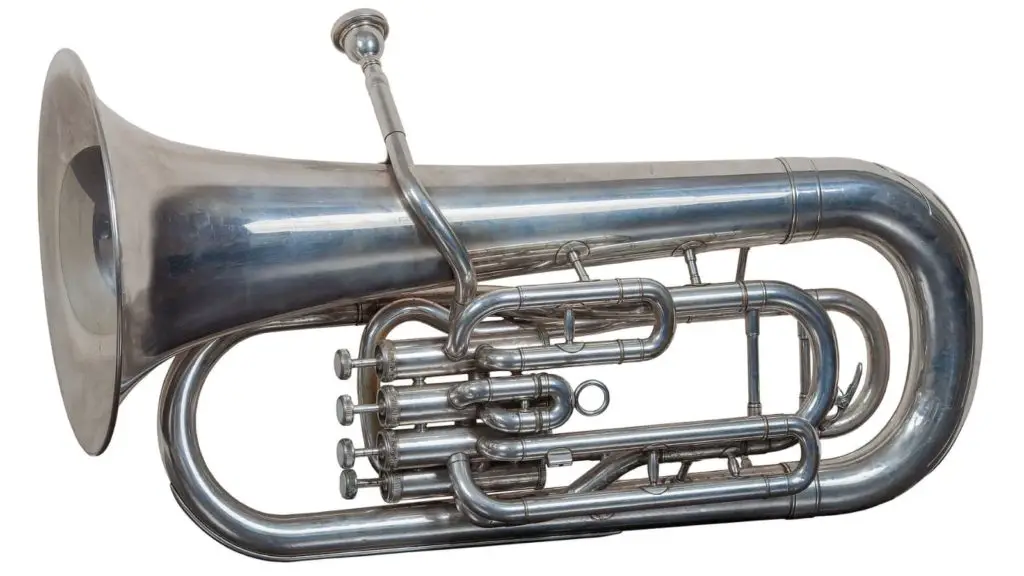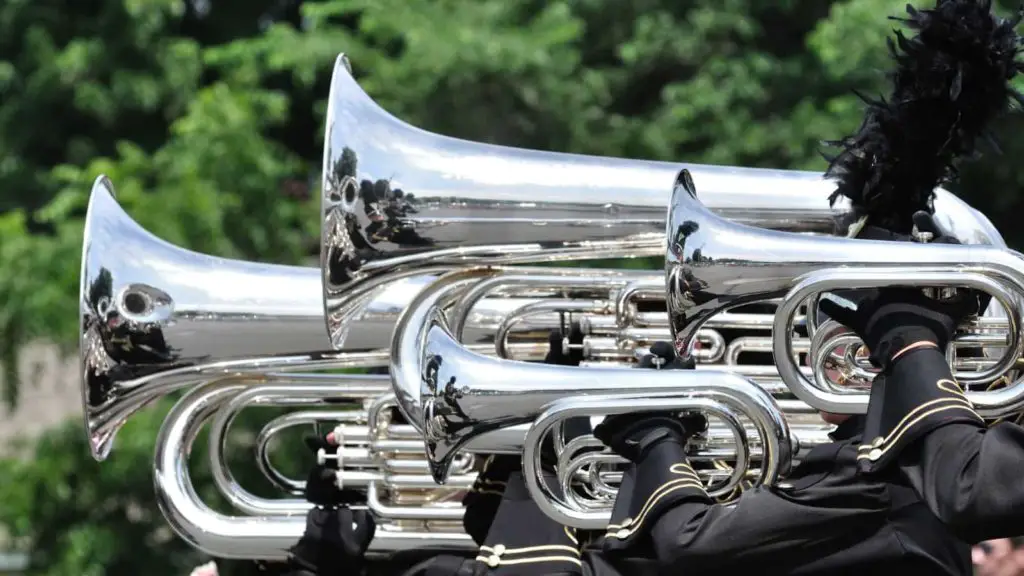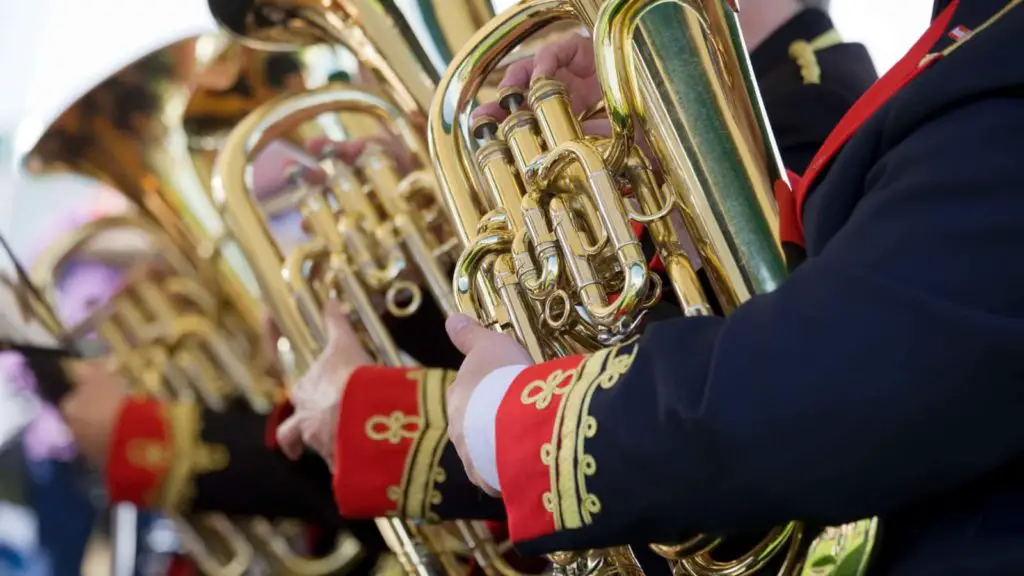If you are a new member of the marching band or have gone to see a halftime show when the marching band is performing, you may have seen a marching euphonium, possibly without realizing it. Maybe you or your child already plays a musical instrument and are planning to switch to the marching euphonium to help the band.
What is a Marching Euphonium?
Marching euphoniums are low brass instruments played in marching bands to help cover the lower range of the marching band.

Are there Euphoniums in Marching Band?
Yes, euphoniums are played in marching bands, though they differ slightly from traditional euphoniums played during indoor concert ensembles.
Euphoniums used during indoor concert ensembles are typically played on your lap with the bell facing upright towards the ceiling. There are euphoniums in marching band, but marching euphoniums are held up like a trumpet with the bell facing out. Both use a cupped mouthpiece, valves, and sound in a range above tuba.
What is a Marching Euphonium Called?
A marching euphonium is simply called a marching euphonium; however, there are additional words used to describe the specific model in more detail. For example, there are “convertible” euphoniums, meaning that you can adjust the instrument for indoor ensemble playing or outdoor marching band playing.
What is a Euphonium Player Called?
Someone who plays the euphonium is called a euphoniumist, a euphophonist, or euphonist. A few examples of professional musicians that play euphonium include Bill Miller, David Thornton, and Demondrae Thurmon, and Steven Mead.
Listen to Steven Mead’s rendition of J.S. Bach’s Second Suite for Unaccompanied Cello, transcribed for euphonium. Enjoy the rich, characteristic tone of the euphonium as he masterfully performs the nearly fifteen-minute composition. Mead recorded the performance last June in his local church, St. Michael and All Angels, in Fenny Drayton, Leicestershire, UK.
How Much Does a Marching Euphonium Weigh?
Outside of the instrument case, marching euphoniums typically weigh between 7 and 8 pounds. For example, a Jupiter JEP1100M Quantum Series Bb Marching Euphonium weighs 7.6 pounds. Inside the instrument case, they will be around 18-20 pounds.
This difference is important to consider as students playing euphonium in school may need to transport the instrument back and forth regularly. Make sure you are prepared for the extra weight and space to store the instrument if taking it home.
Top Tip: Parents may need to help younger or smaller players with transportation rather than their child consistently taking the bus.
What is a Marching Baritone?
A marching baritone is also a low brass instrument very similar to a marching euphonium, covering the lower range of the marching band.
Marching baritones, like most brass instruments (including euphonium), are generally made of metal and have five main parts:
- Mouthpiece
- Lead Pipe
- Tubing
- Bell
- Valves
To produce a sound on the instrument, you blow air through the baritone and buzz your lips into a cupped mouthpiece. The air goes through the lead pipe and tubing, then the sound comes out of the bell, which helps project the sound out into the audience. The player presses valves with their right hand to affect the pitch.
By pressing the valves, the player increases the length of the tubing, lowering the pitch. The player can also make the pitch go up or down by adjusting the speed of the air and lip pressure. Most brass instruments use valves to affect the pitch, but trombones use a slide.

What’s the Difference Between a Marching Baritone and a Marching Euphonium?
The main difference between a marching baritone and a marching euphonium is the bore size; marching baritones have a narrower bore. Marching baritones and euphoniums are also both commonly in the key of Bb compared to other instruments playing in concert pitch; keep reading for more information about this topic.
Brass Bores
The bore is the shape of the tube of the instrument. Brass and woodwind instruments can have cylindrical bores or conical bores.
A cylindrical bore stays generally the same size. Other instruments have a conical bore, which expands gradually up to the bell.
Top Tip: Learn more about this topic in our recent article, Marching Band Bells (Your Complete Guide!)
Marching baritones typically have conical bores, however, they are narrower than marching euphoniums, changing the sound very slightly. Marching euphoniums sound just a bit rounder and smoother, though they typically both play in the same range and most likely the same part in the music.
Transposing Brass Instruments
Marching baritones are made in the key of Bb, but their sheet music is written up a step (i.e. in the key of C). This means the music they play has to be transposed higher than it actually sounds in order for them to sound in the correct key.
Trumpets are another example of transposing brass instruments where their music is written up a whole step. Trumpets, however, play treble clef music and marching baritones typically play in bass clef.
Purpose of Switching Instruments
At times, band directors may need to switch trumpet players to marching baritone to help fill out the low range of the ensemble. Many music publishing companies include “treble clef baritone” parts so students have an easier time adjusting to the new instrument.
By creating these treble clef baritone parts, music publishers keep trumpet fingerings the same for marching baritone, even though the notes actually sound much lower than they are written. Students can be more successful when picking up the marching baritone, especially when memorizing music quickly during rehearsal.
These transposed parts happen for woodwind instruments as well. Other examples of instruments that sound like bass clef instruments but actually read from treble clef music are bass clarinet and baritone saxophone. This is because most times, students switch to these instruments later after already learning to play treble clef music on a higher instrument.
Below is a chart comparing the euphonium and the baritone:
| CATEGORY | Euphonium | Baritone |
| Weight | 7-8 pounds 19-21 with case | 6-8 pounds18-20 with case |
| Bore Size | .571 inch | .500 inch |
| Bell Diameter | 11 inches | 10 inches |
| Range | Generally three octaves (Bb1-Bb4) | Generally three octaves (Bb1-Bb4) |
| Clef | Bass (sometimes written as treble clef, and transposed) | Bass (sometimes written as treble clef, and transposed) |
| Sound | Lower Register | Lower Register |
Pros and Cons of Playing Euphonium in the Marching Band
You may be wondering if there are certain pros and cons to playing the marching euphonium in the marching band.
Pros
- If you like the low-sounding range of the marching band, you will enjoy the tone the marching euphonium produces.
- If you already play a valved brass instrument, the transition will be quite seamless.
- If you have not played a brass instrument before and are learning a new instrument to help the band, the musical parts are typically less technical than other brass instruments such as trumpet so you will likely have an easier time learning parts.
Cons
- Because the marching euphonium is a low brass instrument, it will be heavier than most other instruments in the marching band, though it is still smaller than the tuba.
- If you are more familiar reading treble clef and do not have any experience reading bass clef music, this can create difficulty for some, however many times, there are adapted treble clef parts that help make the transition easier.
- Marching euphoniums are typically smaller sections in the band, so if you like playing the same part in a bit section, this may not be the best fit. Others may enjoy being more independent playing with less people while still being involved in the full marching band.
How to Hold a Marching Euphonium
As mentioned above, the marching euphonium is a low brass instrument that is heavier than most other brass instruments. Holding the instrument correctly with proper hand position is important to successfully participate in the marching band.
If you recall, marching euphoniums have a mouthpiece, three valves, a lead pipe, tubing, and a bell. Each part has specific functions when it comes to the proper carriage.
- Your right hand goes on top of the instrument, with your index, middle, and ring fingers resting on the three valves. Your pinkie rests on the small hook, and your thumb goes under the lead pipe below the first and second valves.
- Your left hand wraps around the middle portion of tubing, using the U-shaped thumb rest, and circular tuning slide with your ring finger.
- You hold the instrument upright with the mouthpiece and lead pipe facing you, and the bell facing away from your body.
- When you are not playing the instrument, you face the bell down towards the floor with the mouthpiece facing up.
Here is a video of the DCI group Bluecoats demonstrating proper horn carriage for more detail.
What is the Best Marching Euphonium?
Our top recommended brands include Jupiter, Yamaha, Adams, and King. All four recommendations offer high-quality instruments at a wide range of price points. Our favorite in terms of quality, affordability, and flexibility is the Yamaha YEP-201M Series Convertible Marching Bb Euphonium.
Yamaha has a long-standing reputation for providing excellent quality in many different areas, including the musical instrument world. You cannot go wrong with purchasing a Yamaha musical instrument, and this includes their marching euphoniums.
The Yamaha YEP-201M is a convertible euphonium meaning you can adjust it for indoor concert playing or outdoor marching band use, as mentioned earlier in this article. This offers flexibility if you plan on using the instrument for both marching band or concert band.
A family purchasing this instrument for their child would only need one instrument for both purposes; a school purchasing the instrument for a student to use would be able to apply the instrument to different situations as needed.
If a family purchases this instrument for their child, the band member would be able to use this instrument going on to play in college and the quality would last, but the instrument is not at the highest price point, still leaving them room to upgrade if they decide to play professionally later on.
You can purchase the Yamaha YEP-201M at Music and Arts; these instruments are also regularly available to purchase used at other sources to save money, but you should be able to inspect the instrument before purchasing as used instruments may not be in the best working condition. You may need to leave room in your budget to have a music technician look at the instrument for regular maintenance if you do buy a used model.
Where Can I Buy a Marching Euphonium?
As the section above mentions, Music and Arts is a well-known and trustworthy supplier of musical instruments. They have stores nationwide so finding one near you should be relatively simple; they also have a website and offer shipping.
Another excellent source for purchasing a marching euphonium or other musical instrument is Woodwind Brasswind. They offer a great selection of brands, free shipping, financing options, and open-box discounts.
You can also check if you have a local music store near you and call to find out what they have available. The local business will truly appreciate your support!
We do recommend avoiding off-brands from Amazon when it comes to musical instruments, as in this department, you tend to get what you pay for.
If you buy a very cheap instrument, chances are you will be paying more in repair costs, if the music store is even able to repair the instrument. Check with your band director if you are interested in purchasing an instrument of your own and find what appears to be a good deal before committing to your purchase.

How Much Does a Marching Euphonium Cost?
A quality marching euphonium even used can run at least $1,000, and the average cost runs up to about $3,000. Around that price point, you reach more professional level instruments for college students majoring in music performance.
Many times, schools provide these instruments for students to play so the entire marching band can use a consistent brand, helping unify their sound.
Like mentioned above, students often switch from an indoor euphonium or another brass instrument to help fill in parts for the marching band. Schools can use their band budget to purchase marching euphoniums, but students can also decide to buy their own if they plan to continue playing in college or as part of their career.
Summary
Overall, the marching euphonium is an excellent instrument offering many musical opportunities. Whether you already play the marching euphonium, you are planning to pick it up for the first time in marching band, or you are a supportive adult trying to learn more about this topic, we hope we helped you learn more about the marching euphonium! Thank you for visiting Top Music Tips!
Disclaimer: This post may contain affiliate links. We only recommend high-quality products that are used and recommended by real musicians. If you use these links to buy something we earn a small commission.
